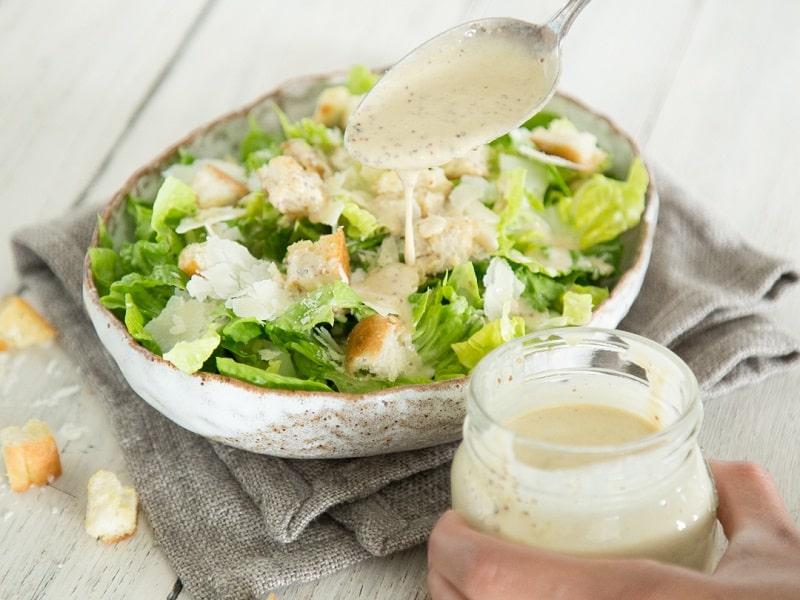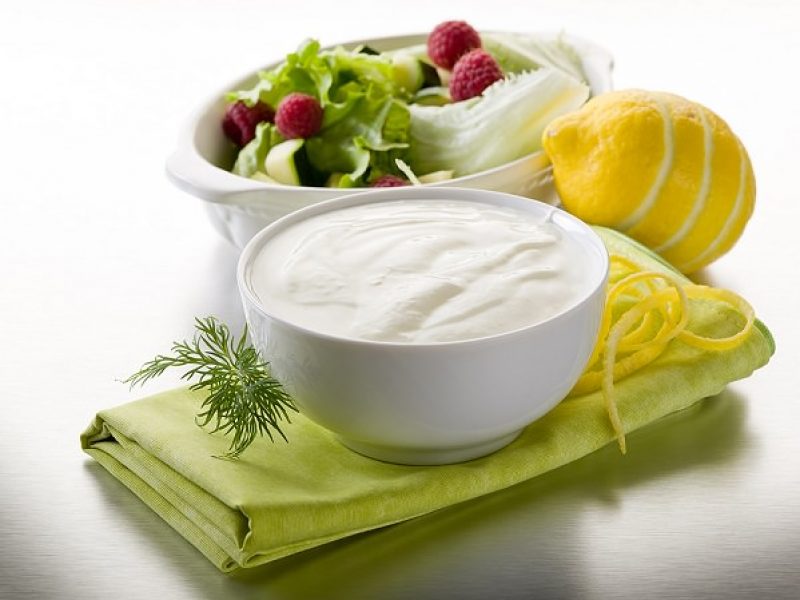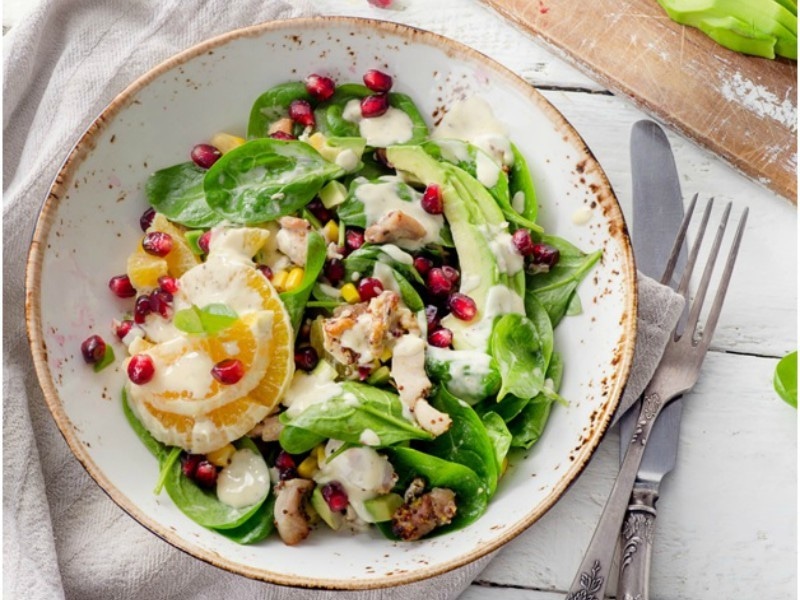Salad sauces are a crucial component in enhancing the flavors and textures of salads. They can transform a simple bowl of greens into a satisfying and delicious meal. There are various types of salad sauces to choose from, each offering a unique and distinct taste profile.
1. Vinaigrettes: Vinaigrettes are perhaps the most popular type of salad dressing. They are made by combining an acid, such as vinegar or citrus juice, with oil, herbs, and seasonings. Vinaigrettes can be easily customized to suit individual tastes, and they can be as simple or complex as desired. Common variations include balsamic vinaigrettes, lemon vinaigrettes, and raspberry vinaigrettes.
2. Creamy Dressings: Creamy dressings add a rich and smooth texture to salads. They are typically made with a base of mayonnaise, sour cream, or yogurt, combined with various flavorings and seasonings. Common examples include ranch dressing, blue cheese dressing, and Caesar dressing. Creamy dressings are especially popular in salads with heavier ingredients, such as chicken or bacon.
3. Citrus-based Dressings: Citrus-based dressings are light, refreshing, and tangy. They are made with citrus juices, such as lemon, lime, or orange, combined with oil, herbs, and sweeteners like honey or agave. These dressings work well with fruit salads, grilled salads, or salads with seafood or poultry. Citrus-based dressings add a burst of brightness to any salad.
4. Asian-inspired Dressings: Asian-inspired dressings draw inspiration from the diverse flavors of Asian cuisine. They often include ingredients like soy sauce, sesame oil, ginger, garlic, and rice vinegar. Asian dressings can be used to create delicious and exotic salads, perfect for incorporating ingredients like tofu, seaweed, or sliced almonds.
5. Italian Dressings: Italian dressings are bold and flavorful, packed with herbs and spices. They typically contain a blend of ingredients such as olive oil, red wine vinegar, garlic, herbs like oregano and basil, and grated Parmesan cheese. Italian dressings are versatile and can be used in a variety of salads, from simple garden salads to pasta salads.

6. Fruity Dressings: Fruity dressings add a touch of sweetness to salads. They are made using fruit juices, such as raspberry, strawberry, or mango, combined with vinegar, oil, and sweeteners. Fruity dressings pair well with salads that contain fruits, nuts, or cheeses. They can also be used to balance the flavors in spicy or savory salads.
7. Tahini Dressings: Tahini dressings are commonly used in Middle Eastern and Mediterranean cuisine. They are made from sesame seed paste, lemon juice, garlic, and olive oil, resulting in a rich and creamy dressing. Tahini dressings are perfect for salads with roasted vegetables, chickpeas, or falafel. They provide a unique nutty flavor and a velvety texture.
8. Yogurt-based Dressings: Yogurt-based dressings are a healthier alternative to creamy dressings. They are made with yogurt as the base, combined with herbs, spices, and other flavorings. Yogurt-based dressings are light, tangy, and refreshing. They are ideal for salads with crisp vegetables, fruits, or grilled meats.
When choosing a salad sauce, it’s important to consider the ingredients in the salad itself and the desired flavor profile. Experimenting with different types of dressings can add variety and excitement to your salads, making them more enjoyable and satisfying.Types of Salad Sauces and Their Business Potential
I. Introduction
Salad sauces are a crucial component in enhancing the flavors and textures of salads. They can transform a simple bowl of greens into a satisfying and delicious meal. In recent years, the demand for healthier food options has increased, leading to a rise in the consumption of salads. As a result, there is a growing market opportunity for businesses that specialize in producing and selling salad sauces. This article will explore the different types of salad sauces and their business potential in today’s market.
II. Vinaigrettes: A Classic and Versatile Option
Vinaigrettes are perhaps the most popular type of salad dressing. They are made by combining an acid, such as vinegar or citrus juice, with oil, herbs, and seasonings. Vinaigrettes can be easily customized to suit individual tastes, and they can be as simple or complex as desired. Businesses can capitalize on the popularity of vinaigrettes by offering a variety of flavors, including balsamic vinaigrettes, lemon vinaigrettes, and raspberry vinaigrettes. These products can be marketed as healthy, flavorful, and versatile salad dressings suitable for a wide range of consumers.

III. Creamy Dressings: Indulgent and Satisfying
Creamy dressings add a rich and smooth texture to salads. They are typically made with a base of mayonnaise, sour cream, or yogurt, combined with various flavorings and seasonings. While creamy dressings may not appeal to health-conscious consumers as much as vinaigrettes, they still have a significant market potential. Businesses can target consumers who prefer a more indulgent and satisfying salad experience. Variations such as ranch dressing, blue cheese dressing, and Caesar dressing can be marketed as premium products, highlighting their high-quality ingredients and exceptional taste.
IV. Citrus-based Dressings: Fresh and Tangy
Citrus-based dressings are light, refreshing, and tangy. They are made with citrus juices, such as lemon, lime, or orange, combined with oil, herbs, and sweeteners like honey or agave. These dressings work well with fruit salads, grilled salads, or salads with seafood or poultry. The health benefits associated with citrus fruits make them an attractive option for health-conscious consumers. Businesses can target this market segment by developing citrus-based dressings that emphasize freshness, natural ingredients, and a balanced flavor profile.
V. Asian-inspired Dressings: Unique and Exotic
Asian-inspired dressings draw inspiration from the diverse flavors of Asian cuisine. They often include ingredients like soy sauce, sesame oil, ginger, garlic, and rice vinegar. Asian dressings can be used to create delicious and exotic salads, perfect for incorporating ingredients like tofu, seaweed, or sliced almonds. With the increasing popularity of Asian cuisine and the growing interest in global flavors, businesses can cater to adventurous eaters who seek unique and diverse salad options. Marketing these dressings as authentic and culturally-inspired products can attract consumers looking for new taste experiences.
VI. Italian Dressings: Bold and Flavorful
Italian dressings are bold and flavorful, packed with herbs and spices. They typically contain a blend of ingredients such as olive oil, red wine vinegar, garlic, herbs like oregano and basil, and grated Parmesan cheese. Italian dressings are versatile and can be used in a variety of salads, from simple garden salads to pasta salads. Businesses can position Italian dressings as a classic and timeless option, appealing to consumers who appreciate traditional flavors and the Mediterranean diet. Emphasizing the quality and authenticity of the ingredients can further enhance the appeal of these dressings.

VII. Fruity Dressings: Sweet and Refreshing
Fruity dressings add a touch of sweetness to salads. They are made using fruit juices, such as raspberry, strawberry, or mango, combined with vinegar, oil, and sweeteners. Fruity dressings pair well with salads that contain fruits, nuts, or cheeses. They can also be used to balance the flavors in spicy or savory salads. With the increasing focus on fruit consumption and the desire for unique flavor combinations, businesses can create fruit-based dressings that cater to health-conscious consumers and those seeking a refreshing and vibrant salad experience.
VIII. Tahini Dressings: Nutty and Creamy
Tahini dressings are commonly used in Middle Eastern and Mediterranean cuisine. They are made from sesame seed paste, lemon juice, garlic, and olive oil, resulting in a rich and creamy dressing. Tahini dressings are perfect for salads with roasted vegetables, chickpeas, or falafel. They provide a unique nutty flavor and a velvety texture. Businesses can target consumers looking for plant-based and vegan options by promoting tahini dressings as a healthy alternative to creamy dressings. These dressings can be positioned as versatile and nutritious options suitable for a variety of salads and dietary preferences.
IX. Yogurt-based Dressings: Healthier Options
Yogurt-based dressings are a healthier alternative to creamy dressings. They are made with yogurt as the base, combined with herbs, spices, and other flavorings. Yogurt-based dressings are light, tangy, and refreshing. They are ideal for salads with crisp vegetables, fruits, or grilled meats. With the growing demand for healthier food choices, businesses can market yogurt-based dressings as low-fat, probiotic-rich alternatives that promote digestive health. Emphasizing the nutritional benefits of yogurt and the flavorful combinations of herbs and spices can attract health-conscious consumers looking to add a nutritious twist to their salads.
X. Conclusion
In conclusion, the market potential for salad sauces is vast, with a variety of options to cater to different taste preferences and dietary needs. From vinaigrettes to creamy dressings, citrus-based dressings to Asian-inspired options, businesses can tap into the growing demand for healthier and more flavorful salads. By focusing on quality ingredients, unique flavor combinations, and health benefits, entrepreneurs can create successful salad sauce brands that resonate with a diverse range of consumers. So, whether you’re starting a new venture or expanding your existing product line, the world of salad sauces offers an exciting opportunity to contribute to the ever-evolving culinary landscape.









